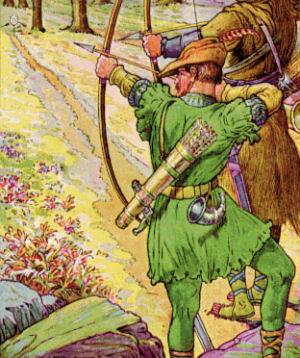Robin Hood - The Man & The Myth - A Summary
 The legend of Robin Hood has evolved and grown over many centuries. The earliest references to an outlaw called Robin Hood are found in hints and allusions from 1228 onwards. We find references to names like "Robinhood", "Robehod" and "Hobbehod" within the rolls of various English Justices.
The legend of Robin Hood has evolved and grown over many centuries. The earliest references to an outlaw called Robin Hood are found in hints and allusions from 1228 onwards. We find references to names like "Robinhood", "Robehod" and "Hobbehod" within the rolls of various English Justices.
By the time Shalespeare came to write "The two gentlemen of Verona" in the late 16th century, Robin Hood was a well accepted part of English folklore. The name became associated with sedition and treachery and in 1605 Guy Fawkes and his associates were branded "Robin Hoods" by Robert Cecil, the 1st Earl of Salisbury. During the 19th century the tales of a Robin Hood who showed great philanthropy, robbing from the rich to give to the poor, were developed mainly as children's stories. In the 20th century the arrival of films allowed the legends to be embellished and grown in totally new ways.
Currently Robin Hood is portrayed as living during the time when King Richard I was away on the 3rd Crusade (1187-1192). During his absence King Richard had granted the incomes from six counties to his younger brother, John. One of these counties was Nottinghamshire in England. In order to raise money for the Crusade Richard also sold Sheriffdoms to the highest bidder. Although John was not regent, in the absence of Richard he has a reputation for treachery and many times had plotted against Richard. So we can begin to see how the strands of the legend were drawn together. Unfortunately this dating is probably completely fictitious as the early references to Robin Hood talk about the King being called Edward without providing further notes as to which Edward!
What can we say about the name Robin Hood?
Well, in medieval times Robert was a very popular name and a diminutive during the 13th century was Robyn or Robin. The surname of Hood was also fairly common. Then we should consider the setting of the tales in the forest. Today we tend to forget just how much of England was covered by woodland and also how the Royal rights to hunting were rigidly enforced. We know that, whilst Richard I was rarely in England and even then was not keen on hunting, the same could not be said of his younger brother, John. When John came to the throne in 1199 he ruthlessly exploited the forestry laws to raise money for his treasury. Resentment at this treatment would have been widespread.
Interestingly we find references to Robin Hood not just in ballads but also in the May day celebrations which were common throughout the countryside. The earliest reference for this dates back to 1518 and the county of Somerset.
What can we say of where Robin Hood lived?
Certainly the forest location is common to all references but Nottingham is not the only location offered up. There are also good claims for Barnsdale, 50 miles to the north and in Yorkshire. Given the commercial value of having an assoication with the legend it is perhaps no surprise that many more locations are now being promoted.
The development of movies during the 20th century has brought the legend of Robin Hood to a worldwide audience. Wikipedia lists some 58 films, animations or serials involving Robin Hood up to and including the Recent Russell Crowe film.
Part 2: Robin Hood - Other Characters In The Medieval Legend


